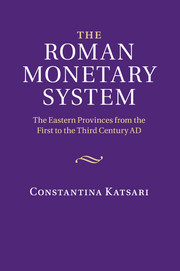Book contents
- Frontmatter
- Contents
- List of charts
- Acknowledgements
- List of abbreviations
- Framing the Roman Monetary System: An Introduction
- 1 Statistics and numismatics
- 2 Planning the financial policy of the Roman state
- 3 Trimetallism and bimetallic laws
- 4 The application of the Quantity Theory of Money to third-century economics
- 5 Roman monetary integration
- 6 Micro-economies
- 7 Metallism vs. chartalism
- Appendix 1 The inscription of Mylasa
- Appendix 2 Excavations finds, coin hoards and museums
- References
- Index
5 - Roman monetary integration
Published online by Cambridge University Press: 01 March 2011
- Frontmatter
- Contents
- List of charts
- Acknowledgements
- List of abbreviations
- Framing the Roman Monetary System: An Introduction
- 1 Statistics and numismatics
- 2 Planning the financial policy of the Roman state
- 3 Trimetallism and bimetallic laws
- 4 The application of the Quantity Theory of Money to third-century economics
- 5 Roman monetary integration
- 6 Micro-economies
- 7 Metallism vs. chartalism
- Appendix 1 The inscription of Mylasa
- Appendix 2 Excavations finds, coin hoards and museums
- References
- Index
Summary
ROMAN SOCIETY AND THE MONETISED ECONOMY
The identification of specific social groups that use predominately precious-metal coinages is essential, if we aim at estimating the level of monetisation in the Roman empire. Gold and silver coins were destined to be used in large transactions either by the state or by the citizens. Such transactions included the exchange of commodities, banking, the liquidation of properties, the exhibition of wealth, investment in businesses, the payment of taxes, the payment of magistrates and army officials or the completion of public works. In previous chapters we analysed the intervention of the emperor in the economy and we gave an overview of his annual budget. In this chapter we should focus on the revenues and expenses of the inhabitants and their involvement in interregional trade and other profitable activities. Once we establish their role in the use of precious-metal currencies, we will have the chance to assess the extent of the monetisation of the Roman economy. To start with, there is an array of questions in need of an answer. For example, who handled the majority of coined wealth within the empire? What was their financial capacity? What type of businesses were they involved in? How is this part of the monetised economy represented among the archaeological finds? Once the answers become clear, we will be able to explore further the integration of the Roman economy, an integration that relied partly on the entrepreneurial activities of the upper and middle echelons of society.
- Type
- Chapter
- Information
- The Roman Monetary SystemThe Eastern Provinces from the First to the Third Century AD, pp. 167 - 208Publisher: Cambridge University PressPrint publication year: 2011



